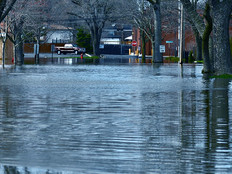How Cities Can Improve Open Data Programs
Some city governments are far along on open data projects and initiatives, such as Washington, D.C., which in 2017 launched The Lab @ DC to address “both large and small projects in the nation’s capital, such as improving the permitting process, exploring how the criminal code is used and evaluating the impact of police department body cameras,” as StateTech has reported.
Los Angeles uses open data in several ways, including visualizing road obstructions for increased situational awareness and faster permitting.
Yet some cities’ open data programs are not as well developed. To help cities launch such programs (and enhance existing ones), the Sunlight Foundation recently released its “Roadmap to Informed Communities.” The roadmap, an update to the foundation’s Tactical Data Engagement framework, is designed to help cities craft open data programs that are targeted to their resident’s needs.
“It can be used by all different kinds of cities depending on cities individual needs,” Becca Warner, a spokeswoman for Sunlight’s open cities project, tells StateScoop.
MORE FROM STATETECH: See how Ann Arbor uses data to get more control over water drainage.
How Cities Can Craft and Enhance Open Data Programs
According to the roadmap, Tactical Data Engagement “is designed to help government staff and other community data providers to catalyze open data’s use for meaningful problem-solving by going beyond publishing open data policies and portals.”
Tactical Data Engagement is a four-step framework “designed for local government staff to develop a resident-centered culture of open data (in the long term) and generate buy-in for resident-centered open data through tactical, meaningful wins for the community (in the short term),” according to the foundation.
The Sunlight Foundation believes that local governments in particular “must go beyond publishing open data because we fundamentally believe that information is power and that all residents have a democratic right not only to access information but to use it.”
The goal, in the foundation’s view, should be for city halls and other local governments to use the roadmap to “catalyze action in communities with the highest need for access to government and public information.”
In particular, the hope is that city leaders will use the framework to “identify and reach out to disenfranchised community members with real information needs, and make a concerted effort to support those communities in using public information for local action. We believe that if all local governments took an intentional, equity-based approach to open data, they could bring real access to power and decision-making to marginalized communities that often go overlooked as audiences for civic technology, open data, and transparency.”
The roadmap is not just for city officials and other public servants who want to work with community actors to get more value out of open data and information, but also anyone who is a data provider, “or who needs to begin segmenting and investigating opportunities for community use of open data can use the strategies we outline here.”
MORE FROM STATETECH: Discover how to make your open data program more effective.
The 4 Steps to Open Data Success
Here are the four main pillars of the roadmap:
- Find: Cities need to listen residents’ concerns and needs by conducting surveys, maintaining relationships with trusted community groups, or regularly joining community meetings. These meetings should be used to collect and analyze broad community interest in open data. From there, city leaders should “identify opportunities where public data or information would empower residents to better understand, address, or collaborate to solve their concerns,” and determine “whether a majority of promising opportunities for the use of open data are clustered around a single issue or focus area.” The result will lead cities to a clear area of focus for their open data efforts.
- Refine: From there, city leaders should explore the focus area for open data use cases “by investigating who community members are, what open data and information they need, and why they need it.” Civic leaders should have an expansive view of what data is, meaning not just structured data in .csv files, but data visualizations residents need to understand their neighborhoods’ health or maps of locations where residents can access city social services.
“As you dive deeper into your focus area, you’ll be looking to gather as much information as you can about who needs open data or public information, what they need, and why they need it,” the roadmap states. Ultimately, city leaders need to continue to reach out to community members to “ground-truth your understanding of residents’ needs for information and data,” and figure out what they need.
- Design: Next, city leaders should figure out how they can support the use cases they identified and map out solutions based on how feasible they are and their potential impact. All of this should be done with community stakeholders. The goal should be to home in on a specific use case. “Limiting opportunities in this step to support only one use case is crucial for taking a tactical, focused approach to facilitating the community use of open data, one iteration at a time,” the roadmap states. At this point in the process, data providers and internal stakeholders “often need to convene internally to assess which use cases” are relevant to internal strategic priorities.
“Narrowing the focus and choosing to support a specific use case opens the door for data providers to convene people who are specifically relevant to the problem at hand to begin co-designing solutions,” the roadmap says.
“Data providers should first narrow down the intended users of relevant data and then decide how to work more closely with them to begin mapping potential interventions like products, projects, or tools. This is the point at which data providers and community members alike can convene to ask: ‘How might we better support this clear use case for open data?’”
- Implement: After all of that, city leaders should work to implement their proposals and “help actual users, identified through previous research and co-design, to carry out the planned intervention that addresses your community-approved open data use case.”
Civic leaders should commit to consistent or open feedback channels with residents to ensure they meet residents’ needs and can actually have an impact. “If your project will be delayed, communicate with community stakeholders about why. Note that the first solution may not always be the best one, and that those members of the community who contributed to the project — and who are the primary users or beneficiaries of community improvements through the use of open data — have crucial insight into any product’s usability,” the roadmap adds.
To build trust with communities, city leaders need to follow through on their commitments and maintain open lines of communication.
“Completing a tactical, community-informed project by using this process can demonstrate to stakeholders inside and outside of your organization that open data has clear applications in addressing pertinent social issues,” the roadmap says. “As data providers continually work with community members to apply open data, they can incrementally increase their maturity and take on harder, more impactful social issues.”






.jpg)



